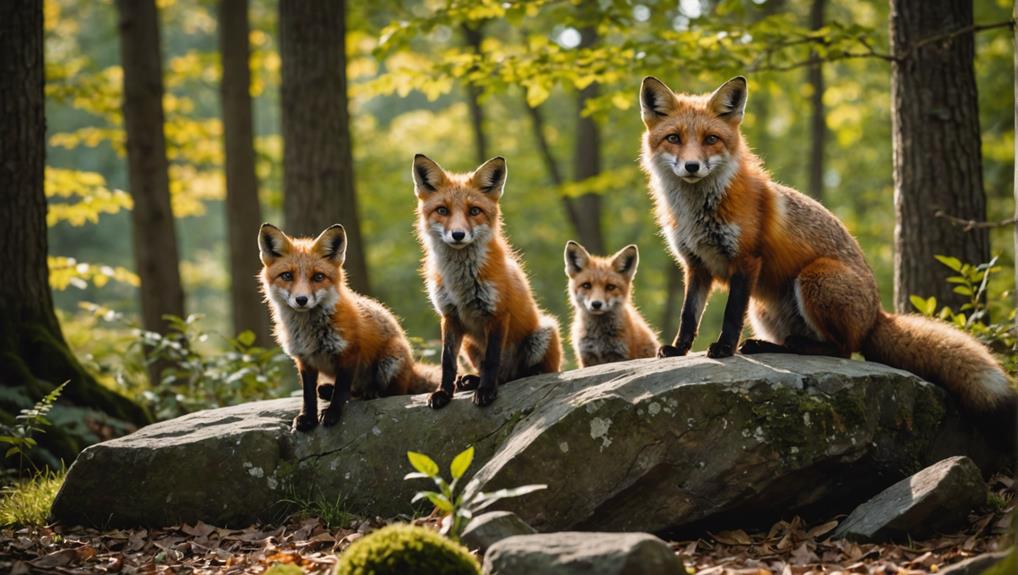Decoding fox social hierarchies in the wild uncovers a unique world where family ties and competition blend harmoniously. Foxes usually stick to a nuclear family model, led by an alpha pair that rules the roost. They communicate through body language and vocal sounds, like the fierce "gekking," to express dominance or submission. As cubs grow, they establish their ranks—often sparring in playful tussles. Resource management becomes vital during food shortages, sparking sibling rivalry. So, if you think you're curious now, just wait until you discover what happens during mating season and how these social dynamics shape their survival!
Contents
- 1 Overview of Fox Social Structure
- 2 The Role of the Alpha
- 3 Mating Behavior and Hierarchy
- 4 Territory Management and Survival
- 5 Communication Techniques Among Foxes
- 6 Function of Subordinate Foxes
- 7 Observing Pack Dynamics
- 8 Aggression and Competition
- 9 Seasonal Changes in Social Behavior
- 10 Research Insights on Fox Hierarchies
- 11 Final Thoughts
Overview of Fox Social Structure
Understanding the intricate dynamics of fox social structures reveals a fascinating blend of family ties and adaptability. You might be surprised to learn that these clever creatures primarily follow a nuclear family model, consisting of a breeding pair and their adorable offspring.
In many species, such as the Gray Fox, these family groups can also include young from previous litters, creating a supportive environment for raising new cubs. It's like a little fox family reunion, but with more tail wagging!
In a fox group, the hierarchy isn't set in stone; it's fluid, changing based on interactions and the group's makeup. As young as three weeks old, red fox cubs start establishing their own social hierarchies. They figure out who's boss, often based on size and strength—talk about a competitive spirit!
Adult foxes also engage in grooming and use body language to reinforce their social bonds. You'll see postures that signal dominance or submission, creating a complex web of relationships.
Territorial management? That's primarily up to the dominant pair, who handle disputes, especially among vixens, with a bit of intrasexual aggression. So, the next time you spot a fox, remember: it's not just a lone wanderer, but part of a dynamic family network, maneuvering life with cleverness and adaptability.
The Role of the Alpha
When you think about the role of the alpha in a fox family, it really comes down to managing resources and keeping things in order.
These dominant foxes not only decide who gets to eat but also hold the keys to breeding rights, which is a pretty big deal in the fox world.
Yet, being the alpha isn't just about being the boss; it's a dynamic position that can change, especially when new foxes join the group, making for an intriguing social dance!
Alpha's Resource Management
The alpha pair in a fox community plays an essential role in managing resources, ensuring that all members have access to food and mating opportunities. Think of them as the diligent managers of a bustling restaurant, where every diner deserves a seat at the table. Their keen oversight helps maintain harmony among the group, as they monitor food availability and guide social interactions.
This resource management is particularly vital in environments where prey is scarce, such as during harsh winters when Arctic foxes rely on their adaptability to find food seasonal dietary needs.
In a fox family, subordinates often look to the alpha pair for direction during conflicts and resource allocation. This leadership isn't just about calling the shots; it's about fostering a cooperative environment.
When tensions rise, the alphas step in, diffusing aggressive behavior and promoting peace—sort of like a referee in a game, keeping things fair and fun.
It's fascinating how quickly the dynamics can shift. When new members join, the alpha pair adapts their resource management strategies, adjusting territory and interactions to keep balance in the group.
By ensuring everyone gets their fair share, they not only reinforce their status but also create a supportive community.
Breeding Rights and Dominance
In fox communities, breeding rights revolve around the dominant pair, typically the alpha male and female, who control access to mates during the mating season. This means that if you're a lower-ranking fox, you might just have to sit on the sidelines and watch the alphas strut their stuff.
It's a bit like being at a dance party where only the coolest kids get to show off their moves! Notably, the social structure of foxes can vary greatly among species, with some, like the Gray Fox, known for their climbing abilities and adaptability in various habitats, exhibiting unique social behaviors.
Hierarchical status plays a huge role in reproductive success. Those not in the alpha position often find themselves excluded from breeding opportunities, which can feel pretty unfair. Before mating season, you might even see some intense scrapping among the ranks as individuals compete for dominance.
It's like a reality show, but with more fur and less drama.
When new foxes join or leave the group, the breeding dynamics can shift. This keeps things engaging! The alpha's control over breeding rights isn't just about making cute baby foxes; it also shapes the community's genetic future.
Social Structure Dynamics
Fox social structures are fascinatingly dynamic, with the role of the alpha shifting as group dynamics change. You might think of the alpha as a strict leader, but it's not that simple! The alpha pair, usually the dominant male and female, manage territory and breeding opportunities, but their power can fluctuate.
Imagine a game where the rules change based on who's present—it's kind of like that among foxes. During tough times, like food shortages or mating season, a little aggression might shake up the social group, leading to new alphas.
Even the adorable red fox pups get in on the action, establishing hierarchies as early as three weeks old. Size and strength play a huge role, shaping their future social standing.
Interestingly, grooming and play fighting aren't just for fun—they're essential for strengthening social bonds. These interactions help reaffirm status and keep the peace within their complex social structures.
Mating Behavior and Hierarchy
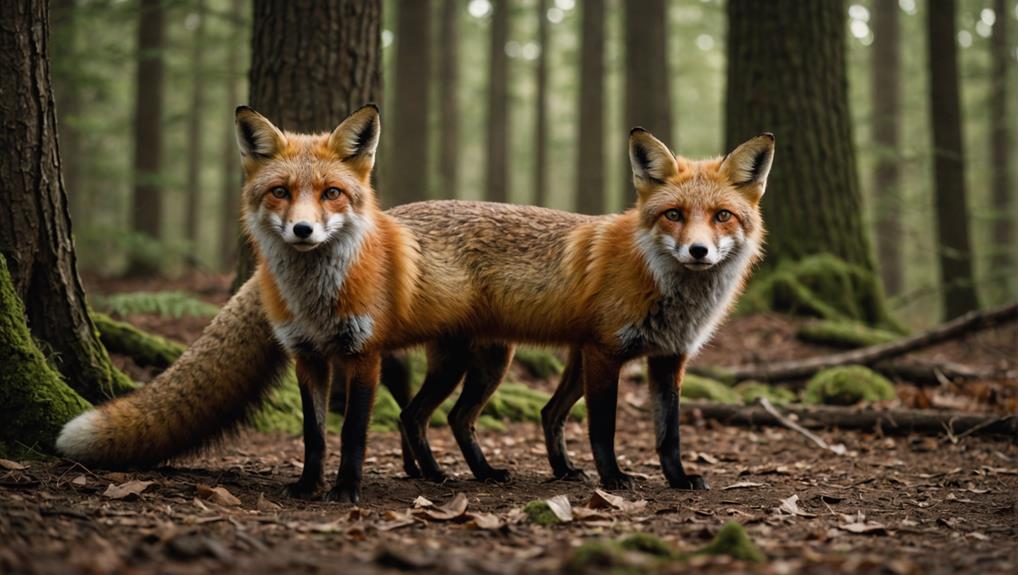
When it comes to foxes, mating isn't just about finding a partner; it's a real competition, and hierarchy plays a big role in who gets to breed.
You'll notice that the dominant alpha pair usually secures the best mates, while others might find themselves pushed aside.
It's a wild game out there, with males showing off their strength and sometimes even getting into tussles, all in the name of love!
Breeding Pair Dynamics
Breeding pair dynamics among foxes reveal a complex interplay of social hierarchy and mating behavior. In a typical fox family, the breeding pairs consist of a dominant male and female. These two not only manage territory but also control which individuals get the chance to mate. It's like a royal court, where the top dogs (or foxes, in this case) get first dibs on resources and mates.
As autumn rolls around, things can get a bit tense. Young male cubs start reaching sexual maturity, and that often leads to some drama. You might see lower-ranking foxes getting pushed out or reassessing their roles within the group.
It's a bit like a reality show, with plenty of squabbles and huffing about who gets to be the king or queen of the den.
Interestingly, the success of breeding is closely tied to social status. Higher-ranking foxes usually have better access to mates and resources, making them the favored ones.
Mating Competition Strategies
Competition for mates among red foxes is a fierce battleground where social hierarchy plays an important role. In this wild world, dominant males often hold the upper paw, gaining better access to potential mates. But the competition isn't just about charm; it can get quite intense!
- Aggressive interactions and physical confrontations can happen.
- Scarcity of food can heighten tensions and territorial disputes.
- Male cubs start to mature in autumn, adding to the family drama.
- Social ranks shift quickly, affecting who gets to breed.
As a caring observer, you'd notice that when resources are low, the stakes go even higher. This means that the competition among males becomes more intense, leading to some bruised egos—and maybe a few injuries!
But there's a twist: social ranks aren't set in stone. They can change rapidly, keeping everyone on their toes.
When you think about it, it's a remarkable dance of nature. It's important to remember that, amid the fierce competition, the ultimate goal for these foxes is ensuring the survival of their lineage.
Territory Management and Survival
Throughout their lives, foxes engage in intricate territory management strategies vital for their survival. You see, dominant fox pairs take charge of their territory, which means they're on guard against intruders and control who gets access to resources.
And trust me, when food gets scarce, things can get a little tense. In fact, about 20% of cubs mightn't make it due to fierce competition for food and those aggressive sibling squabbles!
Territorial disputes often flare up when resources are low, proving how significant resource availability is in shaping their social hierarchies. It's like a game of musical chairs, where the music stops, and everyone scrambles for their spot.
Vixens, especially during mating season, can be quite feisty, showing just how critical those territorial boundaries are.
Foxes also have these complex social structures that can change quickly. Add or remove a fox, and suddenly, everything's different.
Communication Techniques Among Foxes
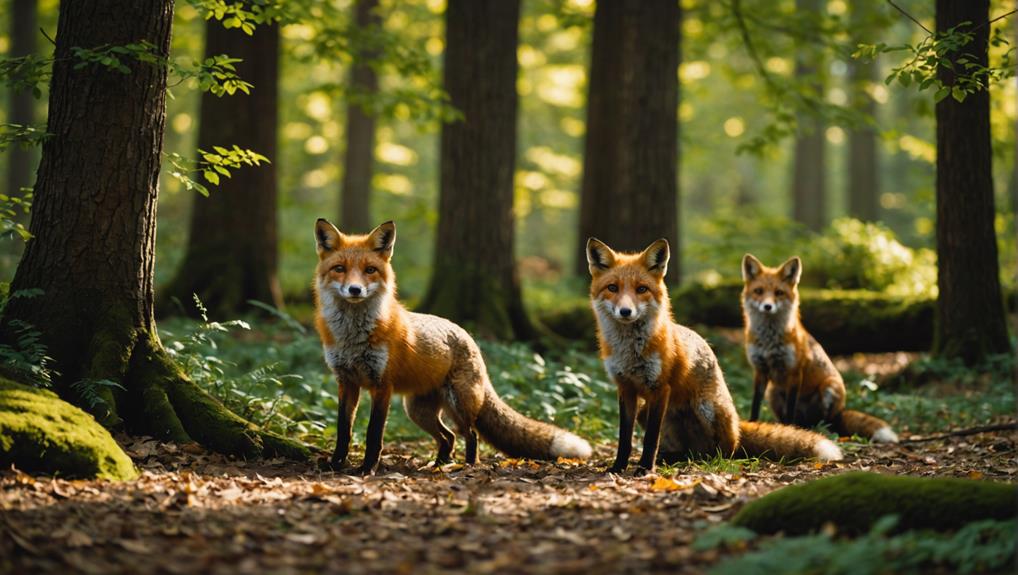
In the world of foxes, communication is essential for maintaining social structures and relationships. These clever creatures have developed a variety of communication techniques to express their feelings and status within the group. You'd be amazed at how they use body language and sounds to convey messages!
- Foxes display dominance with erect tails and upright ears.
- Submissive foxes show lowered heads and flat ears.
- Vocalizations, like "gekking," signal heightened aggression during conflicts.
- Play fighting helps cubs learn social dynamics without real aggression.
Grooming is another important aspect of their communication. When foxes groom each other, they strengthen their bonds and demonstrate their roles in the social hierarchy.
Rendezvous sites become bustling hubs where you can observe greetings, grooming, and playful antics. It's quite a sight to see them engage in play fighting! This ritualized behavior not only reinforces their social status but also allows them to develop important skills without any real danger involved.
Function of Subordinate Foxes
Subordinate foxes play an important role in their social structure, often acting as the backbone of the group. Their position might seem less glamorous, but these foxes contribute considerably to the family dynamic. By engaging in submissive behaviors, like lowering their heads and flattening their ears, they cleverly navigate the hierarchy, avoiding conflicts with dominant individuals while maintaining their social standing.
You might think it's tough being at the bottom, but subordinate foxes still get access to food and cozy sleeping spots, even if they've to wait their turn.
More importantly, they're key players in cub care and social bonding, which helps keep the group stable and happy.
Interestingly, the social ladder isn't set in stone. Subordinate foxes can rise in rank over time, especially when new members join or others leave.
However, it's not all sunshine; around 20% of cubs don't make it past the den phase due to competition for resources.
Observing Pack Dynamics
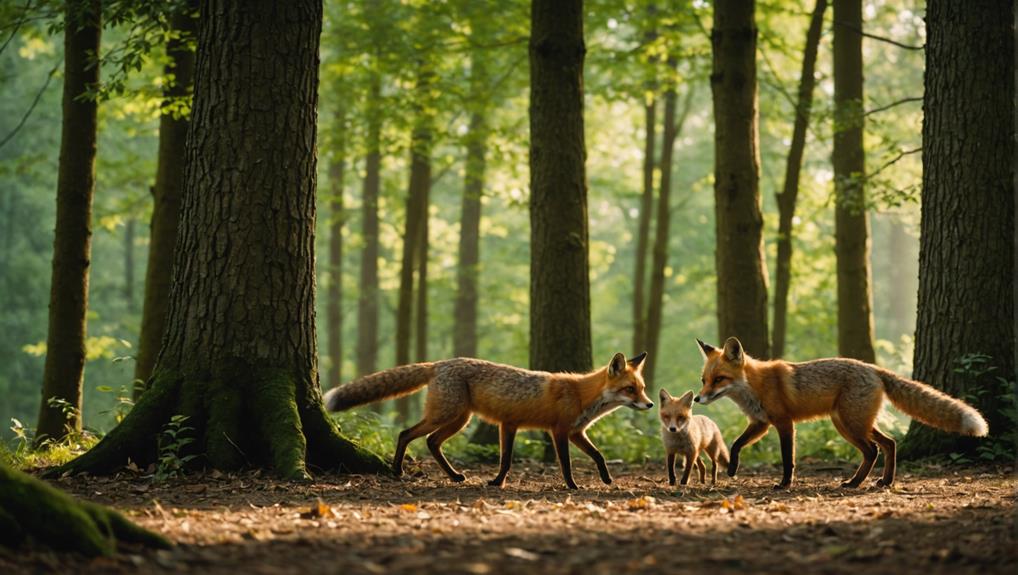
When you watch a group of foxes, you can really see their social structure in action.
The way they interact tells you a lot about their hierarchies, and you might even notice some playful tussles among the cubs that help them learn their place in the pack.
Plus, when food's involved, things can get pretty intense, making it clear just how quickly their dynamics can shift!
Hierarchical Structure Analysis
A significant aspect of fox social hierarchies is the aggressive interactions among cubs that begin as early as three weeks old, setting the stage for their future standings within the pack.
These little furballs engage in some serious play-fighting, and believe it or not, their size and strength can determine who's the boss later on.
Here's what you might notice during this intense cub competition:
- Cubs sparring for food, showing their feisty side.
- Grooming sessions that help strengthen bonds, like a furry family hug.
- Dominant individuals keeping an eye on territory and breeding rights, like royalty.
- Occasional squabbles among adults, especially during mating season, showcasing their complex social dance.
It's fascinating how these interactions shape their social world.
You see, about 20% of cubs don't make it through the den phase, often due to competitive food fights.
While it sounds serious, these dynamics help facilitate the strongest survive.
Interaction Patterns and Dynamics
Understanding how foxes interact gives you insight into their complex social dynamics. These clever creatures start forming social interactions from a young age. In fact, even pups just three weeks old engage in competitive play to establish dominance and secure access to resources.
It's a tough world out there, and about 20% of cubs don't make it through the den phase due to fierce competition for food and space.
As the adults take charge, they manage their territory and breeding opportunities. Their interactions revolve around food availability, which is essential for maintaining harmony.
You might find it interesting that grooming is a key behavior among foxes. It strengthens their social bonds and reinforces hierarchies. Without these affectionate exchanges, some may end up feeling isolated—like the odd one out at a party!
When conflicts arise, aggression doesn't always escalate to physical fights. Instead, foxes often rely on body language and vocalizations to communicate intentions.
It's a bit like a dance, where they use ritualized displays to keep the peace.
Aggression and Competition
Aggression and competition play an essential role in the social dynamics of fox cubs, shaping their hierarchy from a remarkably young age. You may be surprised to learn that these little furballs start establishing their ranks as early as three weeks old! Their size and strength often dictate their social standing, with males typically coming out on top.
Here's a glimpse into their world of competition and aggression:
- Food fights: Scarcity of food can spark skirmishes among cubs, leading to some fierce tussles.
- Dominance displays: Adult males often showcase aggressive behaviors like head turning and body shoving, especially during mating season.
- High stakes: Around 20% of cubs don't survive the den phase, often due to competitive behaviors that can escalate quickly.
- Non-violent resolutions: Curiously, foxes often resolve conflicts through visual signals and vocalizations, reducing the need for physical confrontations.
In this wild setting, aggression isn't just about fighting—it's about survival and establishing a place in their community.
Seasonal Changes in Social Behavior
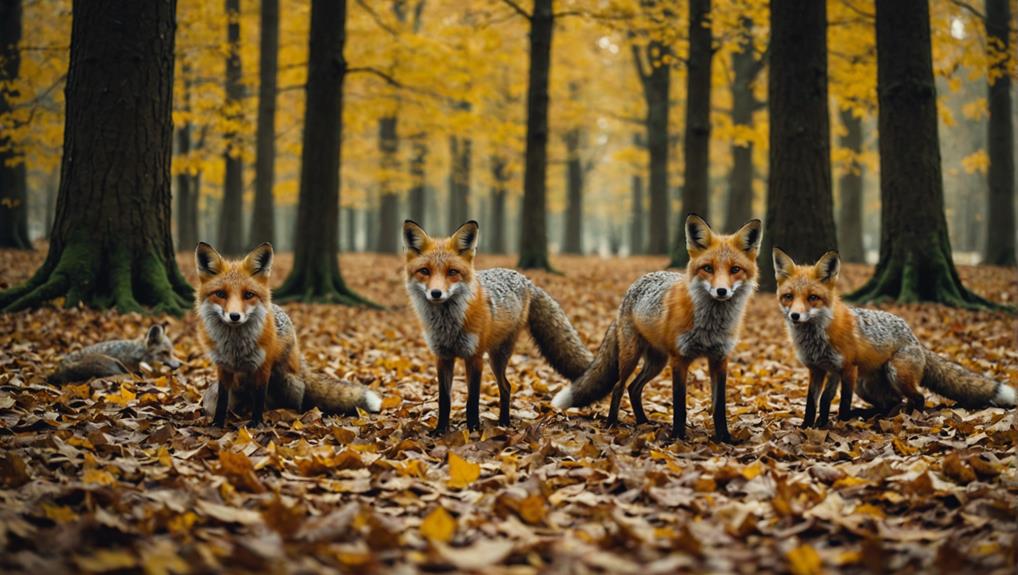
As the seasons change, so do the social behaviors of red foxes, particularly in autumn when male cubs reach sexual maturity. You might notice the family dynamics shifting—tensions can rise as young males start to assert themselves. It's like a teenage drama, but with fur and tails!
During these seasonal shifts, dominant foxes typically breed, which can lead to some serious reshuffling in social hierarchies. When breeding season approaches, you might see a bit of bickering as foxes vie for their place in the pecking order.
Outside of breeding times, though, things calm down. The fox families tend to get along better, allowing for smoother adjustments in their social structures. But don't forget about resources—when food gets scarce, tensions can spike again, leading to territorial disputes. It's nature's way of keeping everyone on their toes, right?
Understanding these seasonal behaviors helps us appreciate the intricate lives of red foxes. By observing how they navigate their social hierarchies, we gain insight into their reproductive strategies and the challenges they face.
Research Insights on Fox Hierarchies
Research on fox hierarchies reveals fascinating dynamics that shape their social interactions. You might be surprised to learn that Red Fox pups start establishing their social ranks as early as three weeks old! They engage in aggressive play, which helps determine who gets the best sleeping spots and the tastiest bites of food.
Here are some key insights:
- About 20% of red fox cubs face tough competition, sometimes leading to unfortunate mortality underground.
- The social hierarchy among foxes isn't set in stone; it changes with the group's makeup, showing their complex nature.
- Higher-ranking foxes often control breeding opportunities, pushing lower-ranking members out before mating season.
- Over a thousand hours of footage have given researchers a peek into their world, showcasing a balance of competition and cooperation.
Understanding these social hierarchies not only enriches your knowledge but also helps us appreciate the resilience and adaptability of these clever creatures.
Foxes, just like us, find ways to navigate their social landscape, and their fierce yet cooperative nature makes them truly remarkable. So, next time you see a Red Fox, remember the intricate world they live in!
Final Thoughts
In the wild, foxes might seem like lone wanderers, but their social structures are quite fascinating. You might think they're just out for themselves, but the truth is, they rely on their pack dynamics for survival and effective communication. By understanding these hierarchies, we can appreciate how teamwork and relationships shape their lives. So, next time you spot a fox, remember, there's more going on beneath that bushy tail than meets the eye!

